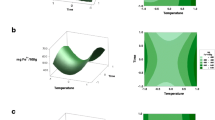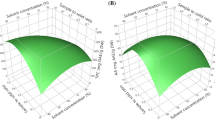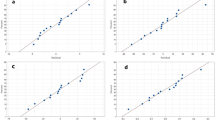Abstract
The present study aims to maximize the extraction of polyphenols from ginger (Zingiber officinale) through the statistical optimization of three influential process parameters ethanol (EtOH) proportion (%), temperature (°C) and extraction time (min). Response Surface Methodology (RSM) was employed to design experiments and study the interaction effects of these parameters on the extraction process. Analysis of Variance (ANOVA) was used for the analysis of regression coefficient, prediction of equation and case statistics. The optimum conditions for the maximum yield of polyphenols from each gram of ginger were found to be 75 % aqueous EtOH, 40 °C temperature and extraction time of 60 min respectively. The order of relative importance of these three parameters was: EtOH > time > temperature. Antioxidant activity of the extracted polyphenols using optimized parameters was also determined by DPPH assay. DPPH radical scavenging activity of ginger extract was compared with Vitamin C and butyl hydroxy toluene (BHT). Finally, this study revealed a cost effective analytical model to maximize the extraction of polyphenols from ginger with higher antioxidant activity. It was also concluded that at lower concentration ethanolic extract of ginger possess high antioxidant activity in comparison with synthetic antioxidants like vitamin C or BHT and thus it can be applicable as potent natural antioxidant in food and pharmaceutical industries for the preparation of functional food.





Similar content being viewed by others
References
Anderson MJ, Whitcomb PJ (2005) RSM simplified: Optimizing processes using response surface methods for design of experiments. Productivity Press, New York, pp 123–133
Anokwuru CP, Esiaba I, Ajbaye O, Adesuyi AO (2011) Polyphenolic content and antioxidant activity of Hibiscus sabdariffa. Calyx Res J Med Plant 5:557–566
Bartley J, Jacobs A (2000) Effects of drying on flavor compounds in Australian-grown ginger (Zingiber officinale). J Sci Food Agric 80:209–215
Bas D, Boyaci IH (2007) Modeling and optimization I: usability of response surface methodology. J Food Eng 78:836–845
Betz O, Kranke P, Geldner G, Wulf H, Eberhart LH (2005) Is ginger a clinically relevant antiemetic? A systematic review of randomized controlled trials. Forsch Komplementarmed Klass Naturheilkd 12:14–23
Derkyi SA, Adu-Amankwa B, Sekyere D, Darkwa A (2011) Optimization of process parameters using response surface methodology for the extraction of formaldehyde-condensable phenolics from pine bark. J Emerg Trends Eng Appl Sci 2:64–69
Escribano-Bailon MT, Santos-Buelga C (2003) Methods in polyphenol analysis. The Royal Society of Chemistry, United Kingdom
Guerrero MS, Torres JS, Nunez MJ (2008) Extraction of polyphenols from white distilled grape pomace: optimization and modeling. Bioresour Technol 99:1311–1318
Jakopic J, Veberic R, Stampar F (2009) Extraction of phenolic compounds from green walnuts fruits in different solvents. Acta Agric Slov 93:11–15
Kim E, Min J, Kim T, Lee S, Yang H, Han S (2005) Gingerol, a pungent ingredient of ginger, inhibits angiogenesis in vitro and in vivo. Biochem Biophys Res Commun 335:300–308
Mensor LL, Menezes FS, Leitao GG, Reis AS, Dos Santos TC, Coube CS, Kitao SG (2001) Screening of Brazilian plant extracts for antioxidant activity by the use of DPPH free radical method. Phytother Res 15:127–130
Myers RH, Montgomery DC (2002) Response surface methodology: Process and product optimization using designed experiments, 2nd edn. Wiley, New York
Nawaz H, Shi J, Mittal GS, Kakuda Y (2008) Extraction of polyphenols from grape seeds and concentration by ultrafiltration. Sep Purif Technol 48:176–181
Park EJ, Pezzuto JM (2002) Botanicals in cancer chemoprevention. Cancer Metastasis Rev 21:231–255
Pinelo M, Rubilar M, Jerez M, Sineiro J, Núñez MJ (2005) Effect of solvent, temperature, and solvent-to-solid ratio on the total phenolic content and antiradical activity of extracts from different components of grape pomace. J Agric Food Chem 53:2111–2117
Platel K, Srinivasan K (1996) Influence of dietary spices or their active principles on digestive enzymes of small intestinal mucosa in rats. Int J Food Sci Nutr 47:55–59
Ranjan D, Srivastava P, Talat M, Hasan SH (2009) Biosorption of Arsenic from aqueous solution using agricultural residue “rice polish”. J Hazard Mater 166:1050–1059
Rodriguez-Nogales JM, Ortega N, Perez-Mateos M, Busto MD (2007) Experimental design and response surface modeling applied for the optimization of pectin hydrolysis by enzymes from A. niger CECT 2088. Food Chem 101:634–642
Roldán E, Sánchez-Moreno C, De Ancos B, Cano MP (2008) Characterization of onion (Allium cepa L.) by-products as food ingredients with antioxidant and antibrowning properties. Food Chem 108:907–916
Schwertner HA, Rios DC (2007) High-performance liquid chromatographic analysis of 6-gingerol, 8-gingerol, 10-gingerol and 6-shogaol in ginger-containing dietary supplements, spices, teas and bevarages. J Chromatogr B 856:41–47
Singleton VL, Rossi JAJR (1965) Colorimetry of total phenolics with phosphomolybdic-phosphotungstic acid reagent. Am J Enol Vitic 16:144–158
Stoilova I, Krastanov A, Stoyanova A, Denev P, Gargova S (2007) Antioxidant activities of a ginger extract (Zingiber officinale). Food Chem 102:764–770
Yang L, Jiang J, Li W, Chen J, Wang D, Zhu L (2009) Optimum extraction process of polyphenols from the bark of Phyllanthus emblica L. based on the response surface methodology. J Sep Sci 32:1437–1444
Yasser FM, Kishk, Hemat E, Sheshetawy EI (2010) Optimization of ginger (Zingiber offcinale) phenolics extraction conditions and its antioxidant and radical scavenging activities using response surface methodology. World J Dairy Food Sci 5(2):188–196
Acknowledgement
The authors would like to express their gratitude to Prof. (Dr.) Gautam Biswas, Director, CSIR-Central Mechanical Engineering Research Institute for his kind permission to publish the paper. The authors are also grateful to Council of Scientific and Industrial Research, Govt. of India for the financial support. The help rendered by our scientific and technical staffs of CAMP, CSIR-CMERI, Durgapur is acknowledged. Sincere thanks to Mr. Dipanjan Sengupta and Mr. Sanjeeb Sutradhar for their support during the preparation of this manuscript.
Author information
Authors and Affiliations
Corresponding author
Rights and permissions
About this article
Cite this article
Mukherjee, S., Mandal, N., Dey, A. et al. An approach towards optimization of the extraction of polyphenolic antioxidants from ginger (Zingiber officinale). J Food Sci Technol 51, 3301–3308 (2014). https://doi.org/10.1007/s13197-012-0848-z
Revised:
Accepted:
Published:
Issue Date:
DOI: https://doi.org/10.1007/s13197-012-0848-z




